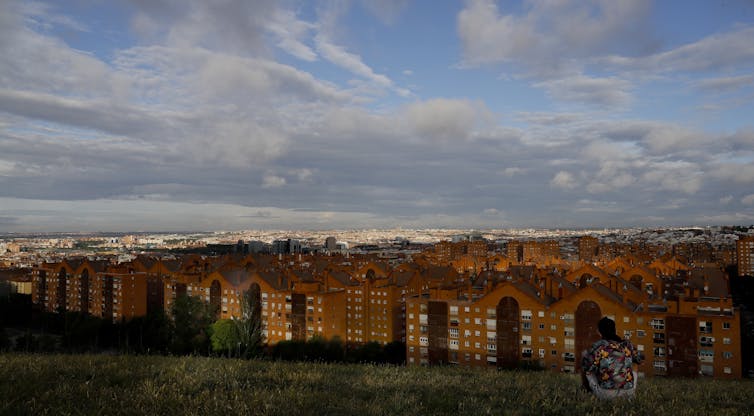Here in the UK, with traffic noise back to drowning out birdsong, and foreign holidays back on the cards, it is easy to forget the weeks of cleaner air. If we do not seize the opportunity to pause, reflect and plan transformative change, the COVID-19 years could end up being just a small and temporary blip in our overall climate trajectory.
Earlier this year, during the lockdown, my daughter and I found ourselves with time on our hands. Her A-level (senior high school) exams had been cancelled and my colleagues had not yet discovered Zoom.
Together we set about a home-school project to find out if and how lockdown might be affecting emissions and thereby climate change. Our results are now published in the journal Nature Climate Change.
Climate and lockdown
It is notoriously difficult to estimate greenhouse gas emissions on short timescales. Weather patterns can interfere with attempts to directly measure the emissions and it normally takes 18 months or more for industry and governments to report their emission data.
My daughter and I needed a faster way to monitor emission change. Building on methods developed by the University of East Anglia and Stanford, we used trends in road transport, industry, power generation and other economic activities as a mirror for changes in greenhouse gas emissions. My reasoning was that if we know what these sectors usually emit, and we know how much activity fell during lockdown, we can also estimate how their greenhouse gas emissions changed.

Much of this was possible thanks to newly accessible global mobility data from Google and Apple. This provided unexpected and novel ways of estimating emission changes from transport, industry, power, public and residential sectors.
It ultimately allowed us look at how lockdown affected emissions in 123 countries, responsible for 99% of global CO₂ emissions. The next step was to calculate, using a simple climate model, how these emissions changes would influence the global temperature over a two year-period, from the start of China’s lockdown to the end of 2021.
We not only estimated sector changes in CO₂, we were also able to apply our method to nine further gases and pollutants. Although CO₂ is the biggest cause of human-induced global warming, other emissions also influence the climate. Nitrous oxides (NOx), which like CO₂ are produced by burning fossil fuels, fell during lockdown, mainly as road transport decreased.
There was also a drop in sulphur dioxide (SO₂) emissions from power plants and heavy industry. As NOx leads to warming while SO₂ helps to form aerosols, which reflect sunlight back to space and help cool the planet, we found that the temperature effects of their reductions almost cancelled each other out.
This left the effect of lockdown’s temporary fall in CO₂ emissions, which we found to be negligible: even if some lockdown measures stay in place for the best part of two years, global temperatures will still only be 0.01°C lower than if we followed an emission pathway where the pandemic never happened.

So rather than helping to tackle climate change, lockdown has left us potentially picking up where we left off. It shows that, even if we lived in a world where the social and economic impacts of lockdown were acceptable, we still need far more serious measures to make a difference – we need structural change.
This is particularly important when it comes to how and where we travel: in the short-term, cutting emissions from road transport could offset warming from cleaning up SO₂ emissions from power generation and heavy industry. But to limit transport emissions in the long-term we need to get more people on public transport and build more cycle lanes.
A climate-friendly recovery?
Right now, governments are making choices about economic recovery that will affect the climate. We modelled how some of these choices play out over the coming decade, again assuming that we definitely won’t have Boris Johnson’s wish of normality by Christmas and that we’ll be living with some level of lockdown until the end of 2021.
The results show how emerging from global lockdown has brought us to a crossroads: an economic recovery that relies on traditional fossil fuels will increase greenhouse gas emissions on top of existing plans by 10% by 2030, meaning we have even less chance of avoiding dangerous climate change.
But investing 1.2% of GDP in a green recovery could reduce emissions by 50% and halve the warming between now and 2050. This would keep the Paris Agreement’s aspirational long-term temperature goal of 1.5°C within sight.
Overall, even a lengthy lockdown will have a surprisingly small impact on the global climate, but COVID-19 has brought an opportunity to pause and reflect, as without concerted global action we will still be on a path towards dangerous climate change. Our work also highlights the public benefit of Google and Apple making their data more available. The data tap is on; they should not turn it off.
Do we revert to normal, or seize the chance for a greener recovery that will tackle the devastating effects of dual COVID-climate crises? As countries are being asked to update their climate ambitions by the end of 2020, let’s make sure governments make the right choice and put the health of the planet and its peoples at the top of their to-do lists.
Source: The Conversation




